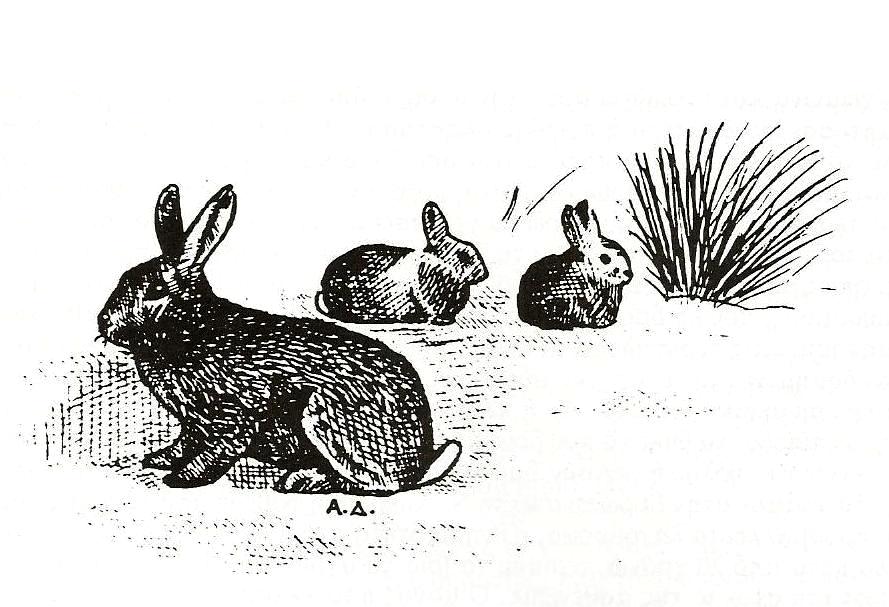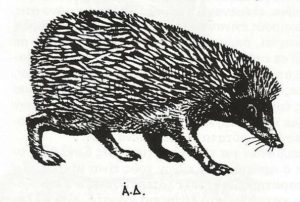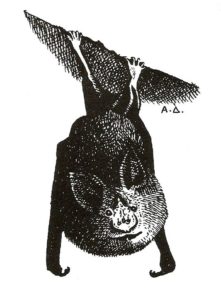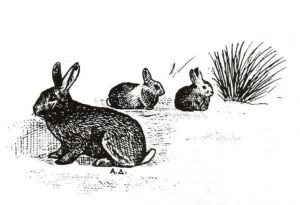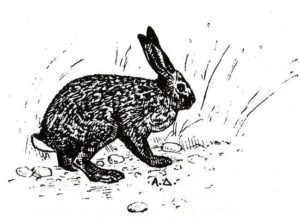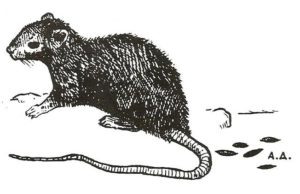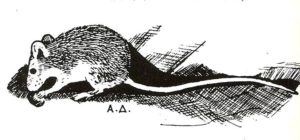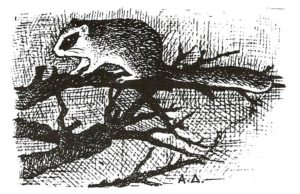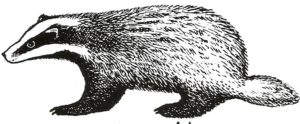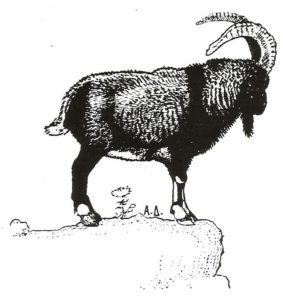by Achilles Dimitropoulos
CONTINUING THE TRIBUTE to the fauna of the Cyclades, Syros Letters are now attempting to approach a less known and least studied group, the Mammals. The first references to this issue were made by Tournefort (1717), Erhard (1858) and Heldreich (1878). To date, the related works are an exception in the international bibliography. The current data on land mammals and micro-mammals are due to Yannis Ioannidis, and for the species Dryomys nitedula, are due to B. Chondropoulos. Today’s tribute responds to the need for the people of Cyclades to know the Mammals of their area, a need that becomes obvious when we find that many people are unaware of, for example, the fact that in our islands there are animals like Asbos (skank) or that they think of whales as rare visitors; even a few years ago, the presence of the Monk Seal in the Aegean Sea was known almost exclusively to the fishermen; most of the islanders, but also in school textbooks, insisted that seals only exist in the northern seas! On the contrary, occasional references have been made to species whose existence in the Cyclades has not been proven, such as the Mustelanivalis (Nyfitsa), in species whose recording is due to erroneous recognitions, such as Tsakali (coyote) of Tinos, which is none other than Asbos, and to species that, if any, seem to have disappeared, such as the Hare or Wild Hare in Syros. Besides, it is to be expected that future investigations will add other kinds to the list of species, especially bats, for which there is a lack of modern data from the Cyclades, with the exception of two very widespread species. The relative rarity of publications for mammals in the Cyclades is probably due to the fact that their number is small. Species that are more common or more observable, such as the Hedgehog, catch the attention of the inhabitants and are more familiar, while others, more shy or hiding, like Asbos, go unnoticed. It is, of course, known that Mammals, in general, are particularly difficult to observe, usually more so than birds and reptiles. Most of them are nocturnal and hiding creatures, who systematically avoid man, and their main means of defense is their acute senses. So even the locals, in places where some species are found, rarely see them. Researchers, in their effort to identify the presence of certain mammals, rely mainly on methods of indirect monitoring or recording, and rarely in direct observation. By using and evaluating the so-called bio-flagging traces (feces, tracks, food remains, nests, etc.) that betray the existence of certain species, scientists identify the presence and activities of mammals in an area—it is on such traces that some testimonies of species in Cyclades are based. Especially marine Mammals, which only by chance can one can meet them.
In Cyclades there are some mammals that are carnivores, such as cats (Wild Cats of Syros) or have a significant impact in “forming” the natural environment of the islands where they live, like the rabbit but also—of course!—the goat or pig in many cases. There are also the foreign, imported species, such as the South American llamas, which were left free on Gyaros in the 1980s. Many species of mammals have a “bad name” in the Cyclades, either for rumored damage (Atsida, mice, Araskos) or superstitions (bats). The mammals, like all the other identity elements of the island natural environment, must be protected in any way.
Insectivores (Insect Eaters)
This class, among the most primitive of mammals, includes about 370 species, belonging to 3 families: Erinaceidae-Hedgehogs, Talpidae-Moles and Soricidae. All insectivore animals have comparatively small, less developed brain and more developed chemosensory organs, while their pointed teeth testify that they feed on insects. In the Cyclades, from the representatives of this class only the Hedgehog has been recorded.
Hedgehog (Erinaceusconcolor). No relationship to hogs! One of the most common mammals in the Cyclades, the Hedgehog is seen often by men. Together with mice, rabbits and rats, it is one of the most popular and widespread animals on the islands. Its thorns (about 6,000) are nothing more than specially formed hair, which of course provide effective protection against the animal’s natural enemies, but not from the car wheels: hedgehog kills on rural roads represent a major threat to the species—it is a very common, macabre sight on the rural roads. Hedgehog is active and moves usually during the night when looking for food. It is then observed relatively easily (by means of a flash light, for example). Although it belongs to the insectivorous class, it feeds on a wide variety of invertebrates (not only insects, but also snails or worms), sometimes vertebrates (lizards, snakes, corpses) and plants. When it eats, it makes noise: it smacks its lips when it chews snails or worms, and it makes characteristic sounds when it cracks beetles with its teeth. Hedgehogs mate in the spring, almost immediately after coming out from their winter hibernation. After a 5-6-week pregnancy, females give birth to 2-10 (usually 4-5) blind young ones, which, however, have few, short and smooth, whitish thorns. They abandon the nest when they are 3 weeks old and follow their mother.
Winged Mammals
This class includes the bats, the only mammals that are capable of a real flight. Their “wings” consist of a thin, flyingmembrane that joins, in most species, the front and back legs, and in some species also the tail.
Bats are typically nocturnal animals, which are rarely observed in daylight. They feed on insects that they grab in the air, usually with their mouths, but sometimes with the help of their flying membrane. Bats eat their prey either while on flight or hooked on some surface. To orientate, they use sounds that they produce, ranging from 10 to more than 100,000 cycles, frequencies that the human ear cannot hear. The animals are oriented with the help of reflected sounds. We also know that some bats use specific cries to communicate with each other. The mouths and nostrils from where the sounds come, as well as the ears of the bats, have been shaped in different ways, characteristic for each species, and so they can be an important element for identifying the species of a bat, if we can see these animals closely. For example, many species of bats have an outgrowth in the inner part of the ear, which is distinguished as a fold or sharp formation, called a [tragos] and is seen in a variety of forms. The cries of bats can be studied with the help of special instruments that convert sounds into frequencies that can be heard by the human ear.
Our knowledge of the presence of bats in the Aegean islands is extremely incomplete, even though these animals are among the most prevalent mammals in the islands. The difficulty of a quick identification does not usually allow, except only to the experts, the accurate recording of existing species. Of the 23 varieties, which have been recorded in Greece, according to Corbet and Ovenden, very few have been observed today in the Cyclades. The islanders call all of them nychterides (bats), from the ancient name nychteris [night creature] (Nychterida in Syros, Nychteria in Kalymnos, Lychterida in Ikaria, Lycharida at Olympus of Karpathos, Tagarida and Tandarida in Leros). Erhard, in his work Faunader Cykladen (p.5), mentions a “new” kind of bat from Syros and he calls it Vesperertiliosoricinus.
The bats in the Aegean islands are mainly found in areas around humid caves and abandoned buildings, cottages and districts with old residences. Because they do not maintain their body temperature constant (normally around 35°–40° C) but adapt to the ambient temperature, the bats are completely dependent on maintaining their shelters, whether caves or ruins or abandoned homes. It is known that these animals fall into a mild, daily lethargy, from which they recover with difficulty, when they wake up are extremely vulnerable, as when they are disturbed during hibernation; then they quickly exhaust their energy reserves. For all the above reasons the protection of the bats in the Cyclades (and the Aegean islands in general) becomes imperative due to the constant decrease of their population, the destruction of the shelters (demolition of buildings, “exploitation” of caves), the inconsiderate use of pesticides, but also of the overall degradation of the natural environment.
Rhinolophus ferrumequinum. Quite large bats: Wingspan 0.33–39 m, body length 00.56–68 m. When hung with closed “wings”, it has a size of a human fist. Her flight is distinctive and reminiscent of a butterfly flight, with “tremulous” movements of the “wings”, alternating by gliding in the air. Noisy, especially near the colonies, makes sounds like shrieks and scratches. Every bat is in constant communication with others around it, crying. When it chases its prey, it often touches or even sits for a moment on the ground, grabbing walking insects. It falls into hibernation in caves, where it goes far enough inside and forms colonies, small or large groups. In the summer moves a lot. In Europe, it has been observed that it can cover up to 40 kilometers each day, looking for food. It has been repeatedly seen in Syros.
Pipistrellussavii. Small bats, body length 00.43–48 m, with distinctive color contrast between the color of the back, the white chin and chest and the black “face”; the hair on the back are dark with much lighter ends. It is often found in villages and towns, and forms colonies of 10 or more bats. This is one of the most common species of bats in the Aegean islands, with a distribution which in the Mediterranean countries includes North Africa and the Canary Islands, while in the east, it spreads through Asia to the Pacific coast. It has been observed in Syros.
Lagomorph (Hare-Like) Mammals
Despite some morphological similarities with rodents, members of this class have nothing to do with mice and rats. In rodents there is always only one pair of incisors in the upper jaw, while in all the hares there is a second pair of incisors, behind the first. In fact, there is a parallel evolution of hares and rodents, to which any similarities are attributable, especially those observed in the skull, a result of functional adaptation. In addition to the well-known “representatives” with the big ears and strong, big hind legs, hares include the pika, a group with short ears and legs, nowadays seen only in Asia and America.
Rabbits (Oryctolagus cuniculus). The Wild Rabbit is a characteristic animal on the Iberian Peninsula, where it originates, but it has spread with the help of man across Europe, including our country, as well as in Australia, New Zealand, South America and hundreds of islands all over the world. The process for its domestication began in Roman times. All domesticated kinds come from the Wild Rabbit and have absolutely no relation to the hare. However, in many of the islands of the Cyclades, the inhabitants confuse the two animals and make no distinction between them: thus, both mainly the pet and the semi-wild rabbit are known in Syros with the name Lagos, the latter living freed from man in the wild (in Ano Meria, in Azolimnos, in Apyamata, in Gaidouronisi and in Stroggylo), even though it is almost certain that there is no (or has never existed?) a hare on this island, despite the fact that Erhard includes Syros on the islands of the Cyclades, where there are hares and not wild rabbits. Perhaps the rarely used name Agriolagos [wild hare] today in Syros is a verbal differentiation of the hares from the wild rabbits, which in any case also means a rabbit nowadays. It is very likely that the Hare disappeared from Syros, as it is certain that releasing rabbits in the wild, taking place now and in the past, is in order for food to be available to any shipwreck survivors. Nowadays, wild rabbits live in the following islands of the Aegean: Mykonos, Syros, Strongylo, Gaidouronisi, Delos, Thira (Platy), Ios, Leros, Kalymnos, Prasouda, Lemnos and Kos. The picture may not be very different from that given by Erhard around the middle of the last century [1800’s], when he mentioned that wild rabbits are found on the islands of Kythnos, Gyaros, Serifos, Kimolos, Delos, Mykonos and Folegandros.
Active, particularly at dusk as well as during the night, the Wild Rabbit does not hide so much on the islands, where it is not hunted, and it can sometimes be seen during the day. It is, however, one of the Mammals that are easier to observe. It digs labyrinthine tunnels into the ground where it hides and bears its young. It delineates its area with feces, which have a characteristic smell, secreted on the feces by special glands; the feces are laid in prominent places, within its “territorial” boundaries. The period of breeding in the Mediterranean countries begins during the winter and ends late in the spring, ie coincides with the period when herbaceous vegetation develops. After a pregnancy of 28-30 days, each female gives birth to an average of 4-6 young, who mature quickly and can mate when they reach 3-4 months. Each reproductive period a female can give birth to up to 30 young, whose mortality can reach at 80%. When there are no major predators, as in some barren islands, wild rabbit populations become so large that they directly affect the natural environment and destroy vegetation. In the case of dense populations, colonies of wild rabbits are structured in hierarchical order, where a strong male usually dominates on some females. If the population density reaches at extremely high levels, females in the lower ranks of the hierarchy do not give birth or give birth only to 1 young. When, in the mid-1950s, the terrible myxomatosis disease that infected the lagomorphs came to Europe from South America, the mortality rate of wild rabbits reached 99%, but after about 20 years, the wild rabbit developed genetic resistance to the virus. The only effective control of this animal’s populations can be done by its natural predators, given the difficulties and limited effectiveness of human hunting, especially in Australia’s typical example, where imported wild rabbits have multiplied to nightmarish levels and are still a problem in many regions of this continent.
Hare, Wild Hare (Ιepus europaeus). In the Cyclades, the Hare is rather a rare, unusual animal, with small, local populations, which are usually limited to specific places. Among the islands of the Aegean, these animals are generally more populated in Samos, Chios, Lesbos, Rhodes, Skyros, Naxos, Kos, where they coexist with the Wild Rabbit, as in the case of Lemnos (Kastro) and Andros, while smaller, geographically limited populations exist in Kythnos, Milos, Serifos, Sifnos, Amorgos, Tinos, Astypalea, Karpathos, Kasos, Kea, Kimolos and Paros. These figures do not differ greatly from those by Erhard, in the middle of the 19th century, when he reported that hares exist in Kea, Syros, Tinos, Milos, Paros, Naxos and Andros. It seems that there are no hares in Syros and Lipsi, while in the smaller islands of the Aegean it is possible that the presence of the Hare excludes the presence of the Rabbit.
Although there is certainly some morphological similarity to the Wild Rabbit, the Hare is a very different animal: its size is generally much larger than the Wild Rabbit and its ears are one-and-half times longer, with black tips. While the length of the Hare ranges from 0.48 to 0.67 m and its weight from 2.5 to 6.5 kilograms, the Wild Rabbit does not exceed 0.34-45 m and 1.3-2, 2 kilograms, respectively. Still the two animals have a completely different way of life: the Hare does not usually dig underground tunnels, but a shallow hall in the ground, it rests and gives birth hidden in dense vegetation, it is not as social as the Wild Rabbit; instead, it is a lonely animal coming out for grazing in the evening. For its defense, it relies both on camouflage, laying still on the ground, as well as on flight, since it can develop great speeds, constantly changing direction—at an angle of 80°, it can continuously monitor its predator. When it is frightened, it makes a distinctive cry. Hares are usually mating in early spring, in March and April. Each female bears to up to 5 young (usually 2), 2 or 3 times a year. In addition to its natural predators, from which it can more easily escape than the Wild Rabbit, the Hare faces hazards and additional pressures from anthropogenic causes, both directly (hunting) and indirectly (destruction and degradation of habitats, expansion of intensified crops, destruction of its shelters), as well as from a number of diseases, such as coccidiosis, which usually strikes populations of hares towards the end of the summer. Although some animals develop immunity, they do not cease to be carriers of the disease affecting the next generations.
Rodents
The largest in number class of Mammals, with the main feature being the presence of 2 incisors in the upper and 2 in the lower jaw, followed by a gap in the position of the canine teeth. The incisors grow continuously while the animal is alive as they wear out by the use. Although most rodents, with the exception of Spalax, which should not be confused with insectivorous moles, see very well and listen even better; they have highly developed chemosensory organs, and we would not exaggerate if we say that they live in “a world of odors.” Representatives of this class meet in all the climatic zones of the earth; the smallest of them is a relative of the house mouse, the African Musminutoides (0.5 m, 5–6 g), and the largest the South American capybara (1.2 m., over 45 kg).
Mus musculus domesticus or Mus domesticus. The most well-known and probably the most common mammal in the Cyclades, where it appears to exist in all the islands (including all the barren islands) and is transported with the help of man. It migrated from Pakistan, in the beginning on its own and then with the help of man, and its distribution spreads to the largest part of the world. Already during the 11th millennium BC, it had reached Israel, by the 7th millennium BC, in Asia Minor and by the second millennium BC, in Egypt and in Western Europe. It is an extremely diverse animal, which can have all the shades of gray and brown in color. The way of life and its habits vary likewise, depending on the area and conditions that prevail and certainly depending on the human presence (one of the proposed names is domesticus). At least 7 different kinds have been described by scientists, based on samples from Europe, and 5 of them have been considered to be quite different so as to be separate species. Mice living close to humans are omnivorous and reproduce throughout the year, while those living in nature (on cultivated land, Mediterranean shrub vegetation, or sparse forests) feed mainly on plant seeds, cultivated or not and on insects, and they mate from March to October. At each birth, after a 20-day pregnancy, it is possible to get 4–8 young mice, who become adult after 35–40 days.
Rat (Rattus rattus). The Rat like the Mouse is the most common mammal in the Cyclades, where it has been transported by humans (abounding in the hull of ships!) even to many barren islands and rocks, and it seems that, like the Mouse, it migrates, colonizing more and more areas within cities or even in the outdoors. As with the Mouse, coloration varies greatly, and there are individuals in all shades of brown, gray and black. Although it originates from India, the Rat has extended its distribution through the classical commercial routes of man, and already it was widespread in the prehistoric period. Today it is populous in the Mediterranean countries, but as we move towards Northern Europe, it becomes rarer.
The Rat living close to humans is an omnivorous animal, but in general this species shows a strong tendency to feed on plant food, mainly fruit, especially when living in the countryside, in cultivated areas (often away from residential areas). Some populations living in the countryside, in the Cyclades, feed on fruit (often carobs) and live on trees. Some scientists classify these populations in a separate species, Rattusfrugivorus.
Armylagus (Dryomysnitedula). A small tree dweller, Armylagus is not easily observed and is one of the lesser known Mammals in the Cyclades. It seems that it exists only in Andros. Its body does not exceed 0,8–13 m in length and its tail is 0,8–9 m. The black mask around the eyes is its most prominent feature and is clearly distinguished as the only spot on the monochrome body that can vary in hue from light gray to brownish red. Its tail is covered entirely by dense hair. It is found in deciduous forests and shrubs from Poland and the Alps to India and China. It makes a tightly woven nest of branches, on the tops of the trees, but also among the foliage of dense bushes. It eats plant food as a very large percentage of its diet. In many areas of its wider distribution, it falls into winter hibernation; but this behavior has not been ascertained for the populations of Andros.
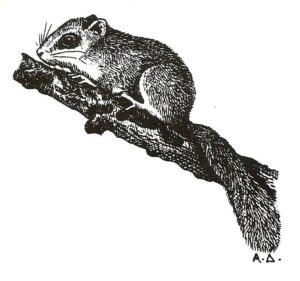 Araskos (Glisglis) [Dormouse]. Araskos is a widespread, tree-dwelling species, which it is difficult to observe (usually, it is seen accidentally), as it is active at night. It looks much like the previous species, but it is noticeably larger, and its black mask is limited to a ring around the eyes. Its color, uniform gray on top and pure white underneath, rarely varies, including brown-yellow tones, or in some samples a darker rib across the back. Its body is 0.13–0,19 m long and the tail is 0.11–0,15 m. It weighs 70–200 g. and, before falling into hibernation, it reaches 300 grams. In the Cyclades, Araskos has been observed only in Andros, where its name came from an ancient Greek origin (Araskos = Orescoos = mountainous, wild). It is also found in most of mainland Greece and in Crete, most of Central, Eastern and Southern Europe, absent from the Iberian Peninsula (except its northernmost extremity). It is imported to a limited extent northwest of London. Outside the borders of Europe, it meets in Russia, Asia Minor, as well as in the Middle East. Exclusively nocturnal, it prefers deciduous forests, shrubs and gardens; it is rarely found in coniferous forests. Noisy, it screams in several tones, especially when it is scared. It is often prey of various kinds of owl. Its winter nest, where it is withdrawn and falls into hibernation, is relatively low on trees or between shrubs, slits of bark or even on the ground, while, on the contrary, it builds its summer nest high up among the foliage of trees, in branch forks and holes. It falls into hibernation from October to April. It mainly eats vegetal food: fruits, seeds, walnuts, hazelnuts, tree bark (it is also considered to cause damage to walnuts and almonds, although responsible here is often the Rat). Depending on the area and season, it feeds on small animals at varying percentages: in some places, it is almost exclusively a herbivore and in other places chases chicks, small birds and insects. It grows fat for the winter, and in the autumn, before falling into hibernation, it gives the impression that it is more bulky than usual. At the beginning of August, the females give birth to 4–5 hairless and blind young ones, who open their eyes after 21 days, but continue breastfeeding for one more week. The pregnancy lasts about 4½ weeks. Araskos lives 6–7 years. The ancient Romans considered this animal a sought-after and expensive delicacy. They raised many of Araskos in large cages to later move them into smaller cages (gliraria, from the Latin name of the animal Glis) and there to fatten them regularly with acorns or chestnuts. When they reached the desired weight, they killed and ate them, as one would eat the most sought-after delicacy that a gourmet table might have. Even today it is known in England as Fat or Edible Dormouse.
Araskos (Glisglis) [Dormouse]. Araskos is a widespread, tree-dwelling species, which it is difficult to observe (usually, it is seen accidentally), as it is active at night. It looks much like the previous species, but it is noticeably larger, and its black mask is limited to a ring around the eyes. Its color, uniform gray on top and pure white underneath, rarely varies, including brown-yellow tones, or in some samples a darker rib across the back. Its body is 0.13–0,19 m long and the tail is 0.11–0,15 m. It weighs 70–200 g. and, before falling into hibernation, it reaches 300 grams. In the Cyclades, Araskos has been observed only in Andros, where its name came from an ancient Greek origin (Araskos = Orescoos = mountainous, wild). It is also found in most of mainland Greece and in Crete, most of Central, Eastern and Southern Europe, absent from the Iberian Peninsula (except its northernmost extremity). It is imported to a limited extent northwest of London. Outside the borders of Europe, it meets in Russia, Asia Minor, as well as in the Middle East. Exclusively nocturnal, it prefers deciduous forests, shrubs and gardens; it is rarely found in coniferous forests. Noisy, it screams in several tones, especially when it is scared. It is often prey of various kinds of owl. Its winter nest, where it is withdrawn and falls into hibernation, is relatively low on trees or between shrubs, slits of bark or even on the ground, while, on the contrary, it builds its summer nest high up among the foliage of trees, in branch forks and holes. It falls into hibernation from October to April. It mainly eats vegetal food: fruits, seeds, walnuts, hazelnuts, tree bark (it is also considered to cause damage to walnuts and almonds, although responsible here is often the Rat). Depending on the area and season, it feeds on small animals at varying percentages: in some places, it is almost exclusively a herbivore and in other places chases chicks, small birds and insects. It grows fat for the winter, and in the autumn, before falling into hibernation, it gives the impression that it is more bulky than usual. At the beginning of August, the females give birth to 4–5 hairless and blind young ones, who open their eyes after 21 days, but continue breastfeeding for one more week. The pregnancy lasts about 4½ weeks. Araskos lives 6–7 years. The ancient Romans considered this animal a sought-after and expensive delicacy. They raised many of Araskos in large cages to later move them into smaller cages (gliraria, from the Latin name of the animal Glis) and there to fatten them regularly with acorns or chestnuts. When they reached the desired weight, they killed and ate them, as one would eat the most sought-after delicacy that a gourmet table might have. Even today it is known in England as Fat or Edible Dormouse.
Carnivores
Acharacteristic of all animals belonging to this class is the existence of developed canine teeth, suitable for holding on to the prey and to tear the flesh. Carnivores are divided into two major categories: those with fins (like seals, sea lions and sea elephants) and those with toes on their limbs (all known terrestrial carnivores, from wolf and dog to bears).
Asbos [Badger] (Melesmeles). Other names: Esvos, Arkalon, Jackal (Tinos), Azos (whence Azidi, Azida, Atsida). While, widespread in mainland Greece, Asbos has a very limited distribution in the Cyclades. It definitely exists in Tinos; we also have reports from Andros and Sifnos. It is easily recognizable, although it is difficult to meet the animal itself. Much larger than the Atsida, which does not exist in Tinos, but it is abundant in most of the other islands, it stands out from the light top of the body, which contrasts with the dark, almost black underside. The striped black and white head is characteristic. Overall length 0.65–90 m. Weight 6–17 kg.
It moves and searches for food during the night, leaving characteristic traces (turning somewhat inward, at least equal in width and length, and 5 fingers clearly visible). It is from these traces, but also from hair, e.g. left on barbed wire in the fields, that its presence in a certain area is established. One rarely meets it during the day, but rather more often at dusk. Equally characteristic as the appearance and the traces is its nest, a large, simple or complex tunnel, which can be very old and can have several exits (diameter 0.20-50 m); another characteristic is also the “outdoor toilets” near the nest: small holes in the soil, where feces are deposited. There is typically a large amount of soil under the nest’s exits. Asbos, being an omnivore, eats almost everything it finds at his nightly excursions, like the Hedgehog: herbs (fruits, nuts, seeds) and various animals (from insects and snails to rabbits, chicks and carcasses) are included in its diet . Quite a social animal, Asbos restricts its activities in the winter but does not fall into a real hibernation. 1–4 youngsters are born towards the end of the winter, after a prolonged pregnancy (there are intervals that the embryos do not develop). The new born stay close to their mothers up to one year after their birth.
 Atsida [Ferret] (Martesfoina). Other names: Atsidi (Syros, Naxos), Azidas (Chios), Aitoulas, Aitoulakas (Andros), Zouridas, Zouria (Karpathos), Nyfitsa, Nyfitza, Marturion (It. martoro), Zerdabas (Turk.), Kolosyntecnaria (Crete), Mouse-Ferret (Samos). Atsida, as the Ferret is called in the Cyclades, is found in most of the larger Aegean islands. It is particularly populous in Andros, but it is absent from Tinos where one finds Asbos.
Atsida [Ferret] (Martesfoina). Other names: Atsidi (Syros, Naxos), Azidas (Chios), Aitoulas, Aitoulakas (Andros), Zouridas, Zouria (Karpathos), Nyfitsa, Nyfitza, Marturion (It. martoro), Zerdabas (Turk.), Kolosyntecnaria (Crete), Mouse-Ferret (Samos). Atsida, as the Ferret is called in the Cyclades, is found in most of the larger Aegean islands. It is particularly populous in Andros, but it is absent from Tinos where one finds Asbos.
Smaller than Asbos, but also the wild cats in the Cyclades, Atsida has a length of 0.42–48 m and a weight of 1–2 kilos. It stands out from the uniform, dark brown color, interrupted by a light or white spot of varying extent in the chest; this spot may be very limited or even completely absent (more often in some, not all, specimens from Crete). Many dead specimens soon whiten from the sunlight in the upper part of the body.
Atsida is usually active during the night. The more it is pursued in an area, the more nocturnal habits it acquires. During the night, one can hear its characteristic, strong cry. It feeds on any small creature that it can kill, but a large percentage of its diet is made up of mice, while in the autumn it is more likely to eat plant food. It typically places its feces in visible spots, on stone walls or rocks.
It nests in cracks of rocks and openings of the ground or between stones, very often in villages and towns (mainly but not necessarily in abandoned buildings), like Chora of Andros or Ermoupolis of Syros (Haravgi). Since it moves around at night, its presence usually goes unnoticed, although in the Cyclades (Andros, Syros, Serifos, Kythnos, Naxos, Thira) it often grows into large populations and seems to thrive in residential areas and around human activities. Apart from the Cyclades, it has a wide distribution throughout Greece. Although it moves mainly on the ground, it climbs very skillfully and chases the same effectively on the roofs or trees. It mates late in the summer, but it gives birth in the next spring. The little ones stay near their mother for 4–7 months.
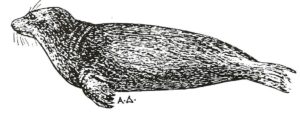 Mediterranean Monk Seal (Monachus monachus). The Mediterranean Monk seal is one of the rarest and most endangered species of Mammals all over the world. At the time that this article is written (April 1994), the latest calculations (Cebrian 1994) bring the total population to an extremely low level: 385–505 individuals survive, while in the greater Greece-Turkey-Cyprus-Libya region there are 120–250 individuals. Under these circumstances, only coordinated and determined efforts could save the species from extinction. The appropriate actions to date are rather limited geographically (in the Ionian and Sporades, for example), moreover it is not easy to extend or apply the same protection strategy across the entire marine area, given the monitoring and surveillance problems.
Mediterranean Monk Seal (Monachus monachus). The Mediterranean Monk seal is one of the rarest and most endangered species of Mammals all over the world. At the time that this article is written (April 1994), the latest calculations (Cebrian 1994) bring the total population to an extremely low level: 385–505 individuals survive, while in the greater Greece-Turkey-Cyprus-Libya region there are 120–250 individuals. Under these circumstances, only coordinated and determined efforts could save the species from extinction. The appropriate actions to date are rather limited geographically (in the Ionian and Sporades, for example), moreover it is not easy to extend or apply the same protection strategy across the entire marine area, given the monitoring and surveillance problems.
In Greece, the Seal was once not rare. Until the middle of this century, there were significant seal populations in the Ionian Islands, the Corinthian Gulf, the coasts of the Peloponnese, of East Greece, in Crete, Evia, the Cyclades, the northern and the eastern Aegean. In the systematic recordings of Marchessaux and Duguy, 1974–1976, at least 15 individuals were observed only around Syros, when the total population of the Cyclades was estimated at 70–90. However, since the first recordings, many things have changed. It seems that Goedicke’s pessimistic calculations, which predicted an overall decline in the 1980s, with many extinctions of local populations in the 1990s, are not far from today’s reality. With this in mind, the Mediterranean Monk Seal is Europe’s most endangered mammal, likely to fall below survival limits in the first decade of the 21st century. The Mediterranean Monk Seal is a large animal that can reach 3.80 m in length, but usually ranges around 2.20 m and weighs up to 230 kilos. Newborns are about 1 m in length and weigh 10–20 kilos. Coloration varies considerably from individual to individual. Although there are no specific rules, males tend to be darker and females often have white or yellowish spots on the underside of the body. The basic coloration can be brown, black, silver or gray, with or without lighter spots on the underside of the body. However, both totally white and totally black individuals have been found.
The diet of the Mediterranean Monk Seal includes fish, octopuses and lobsters. As a result, the fishermen have always considered the seals to be their “competitor”, and the attitude they held towards them ranged from indifferent to hostile. At present, no protection program for this animal can exclude the participation of fishermen who are in direct contact with the populations and refuges of the Monk Seal. Pressure on the populations has undoubtedly increased and, especially in the Cyclades, seals are becoming increasingly rare. After 11 months of gestation, the female Mediterranean Monk Seal bears one child every 2 years, which it breastfeeds for 6 weeks. Most births occur in September or October. The life of the Monk Seal is estimated at 30–35 years.
Ruminants [Regurgitating Mammals]
These animals are herbivores with rumination as a common characteristic, from which they are named. This is an unusual way of digesting due to the peculiarity of their digestive system: the stomach consists of 4 chambers, 1 large and 3 smaller, allowing the animals to regurgitate the food, from the stomach to the mouth, in the form of small balls, and chew it. The ruminants include some of the most known pets: the cows, the buffaloes, the goats and the sheep.
Wild Goat of Eremolilos [Ibex] (Capraaegagruspictus). Endemic subspecies, found only in Eremomilos (Antimilos) and related to Agrimi or Aigagro of Crete (C. a. Cretica). Both Greek subspecies resemble each other, but the subspecies of the Cyclades are characterized by a reddish-brown color, especially the female, and the black spots of the body (back, forefoot and shoulder, beard and upper tail). The Wild Goat of Eremomilos was known at the time of Erhard, who in the work of Faunader Cykladenattempts to differentiate this animal from Agrimi of Crete, mainly because of the deviation and the form of the horns (but also the shape of the male beard). However, the coloration of the animals is not, by itself, a reason for differentiation, since it can vary according to gender and age. Erhard had proposed the name Aegoceruspictusfor this animal.
Nowadays the Wild Goats of Eremomilos are protected, and at least in the immediate future they are not threatened with extinction, although the conditions on the island, with the lack of surface water, are not the most favorable. The greatest danger seems to come from the genetic mixing with (domesticated) goats, and doubts have indeed been expressed about genetic purity, even for the very identity of these animals. Horn divergence and coloration are direct indicators of the particularity of each specimen. The Forestry and the inhabitants of Milos have been making significant efforts for the protection of Wild Goats for years.
The Wild Goat is an ancestor of today’s domestic goat and looks much like it. Intermediate species have been and still are today widespread throughout the Mediterranean, especially in the Greek islands; but nowadays it has become evident that there is a great degree of genetic mixing of these animals, so much that they are no longer considered wildlife species. An exception is the Cri-Cri of Crete (Capraaegagruscretica). Some populations on some islands appear to have been imported from Crete and elsewhere (the species is also found in southwestern Asia Minor) already since the time of the ancient Greeks. The Wild Goats live in groups where the males make a strong presence during the mating season late in the autumn and winter. They feed on a wide variety of plants either by grazing or cutting leaves and stems from the trees, resting on the hind legs and standing up, like the goats. In Eremomilos there is currently a population of Wild Goats, which consists of 400–500 individuals. This population is considered to belong to the subspecies Capraaegagruspictus, which is not found anywhere else. Most of the individuals of this population, show more or less visible signs of hybridization with domestic goats, a problem that characterizes the Greek Wild Goat populations as a whole and, to limit it, all hybrids and domestic animals that live on Eremomilos should be distroyed. It should also be appropriate to protect the whole island by designating it as a national park and to keep the goat population at levels that do not reach the limits of artificial overpopulation due to complementary food supply (Sfoungaris 1990).
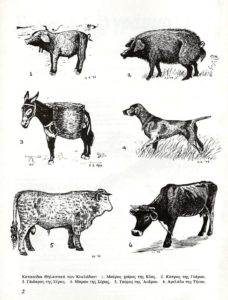 Pets and Domestic Animals
Pets and Domestic Animals
Apart from wildlife living in the Cyclades, there are domestic animals found on some islands descended from very old, often small, breeds. Today most of these breeds have already disappeared or tend to disappear, and their protection is required. These breeds are the result of centuries of adaptation to the arid, inhospitable environment of the islands, where these animals had to survive and produce for men, exploiting highly degraded food sources, or tolerate adverse environmental conditions, with the main problem being the lack of surface water. Companions of the islanders in long, hard periods, Cycladic domestic animals have so far arrived to be replaced by the wheel, improved breeds, and the intensification of agricultural production; this, even when the profession of animal farming is abandoned on islands like Syros. The brak (sic) of Syros, the pig of Kea, the donkey of Syros, and the cow of Tinos, as they were known in the daily talk of the islanders, will soon disappear if there are no breeding cores to reproduce them. To these breeds one can add animals which have been imported to the islands on a periodic basis, preserved for a period and then declined, such as the “heavy” Hungarian horses and the “camatera [burden]” buffalo (in Syros), even the South American Llamas (Gyaros). Cats, goats, pigs and rabbits are present in the wild on many inhabited and barren islands of the Cyclades (Gyaros, Gaidouronisi, Rinia etc), and often these populations are the result of old imports (in the case of cats and rabbits, these populations come from imports that were made centuries ago but are also reinforced by repeated “inflow of new blood”). In many areas, such as in Sa-Mihalis of Syros, as well as in entire islands such as Gyaros, the inhabitants abandoning their homes (gradually in the first case, suddenly in the second), released the animals, leaving them to their fate and so they created a new population in nature. Elsewhere, as in Gramvousa, the inhabitants systematically abandoned their animals when they grew old, not to kill them. Thus, many of these islands were named Gaidouronisia [Donkey Islands] for that reason (perhaps the information that the islanders killed or abandoned the old animals in certain places, such as Lazareta in Syros should be added here). Only few cows of the Tinos breed survive today, since it has been displaced by improved breeds, which are regularly bred throughout Greece. A particular breed, which seems to be a cross of Schwitz with the Russian cow, or the cow of Tinos, it resembles in some of the morphological characteristics the Indian Zebu. Despite the poor diet of these animals, their yield was very satisfactory, with milk production reaching 1,000 kg per year and a fat content of 5,20%. The height of the animals of the Tinos breed is 1,18–1,36 m and the weight is 325–340 kilos, while their color is blond, fiery or silver-blond. The bulls (bugades; bugas, bugadi, in the local idiom of Tinos and Syros) were raised for fattening. Several local cow breeds existed previously in the Sporades Islands—where few specimens are preserved today—but also in Gavdos. These animals were brownish or whitish, while the bulls were white with varying gray tones in the head and the front neck. Their horns were sickle-shaped and larger than those of the bulls that belonged to the Cyclades.
source: Syros Letters, Vol. 29, 1995
Translated by Constantine Hatziadoniu

